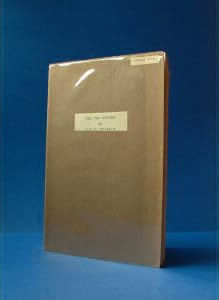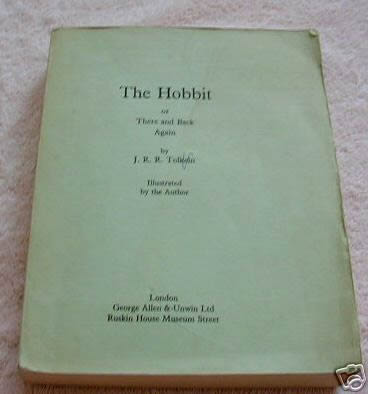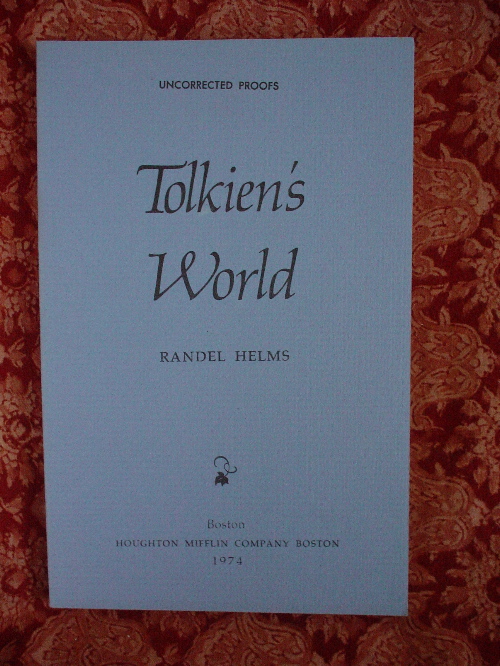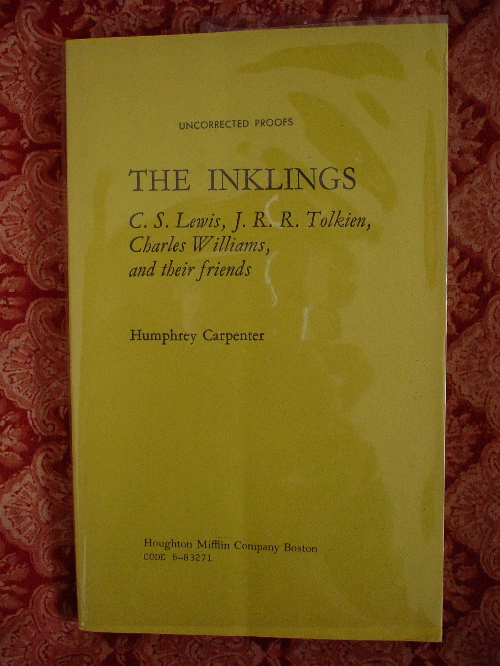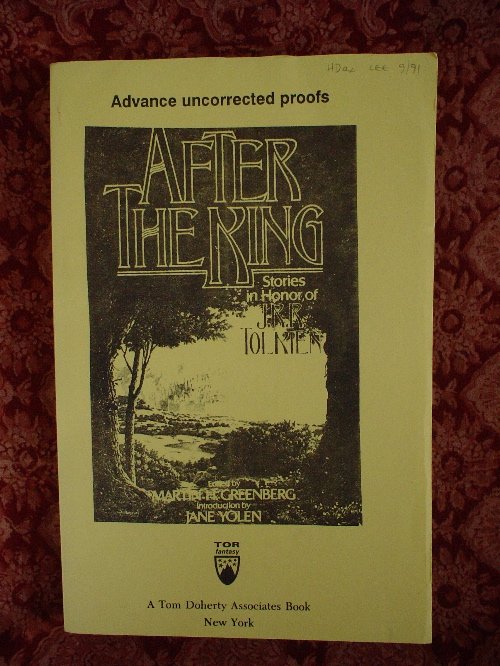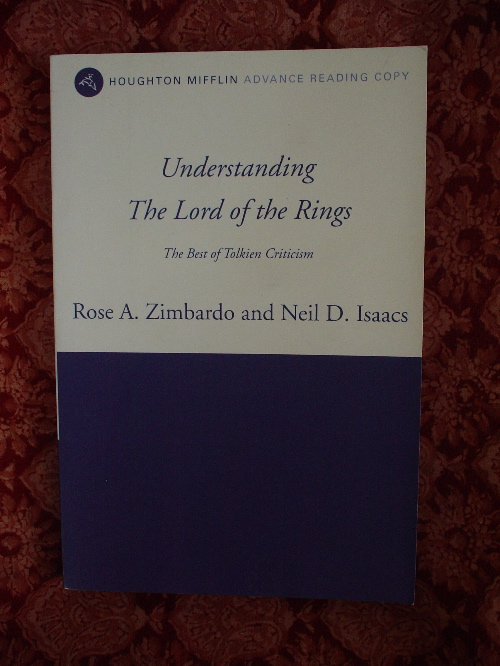Collecting Tolkien Advance Reading Copies (21.02.05 by Pieter Collier) - Comments
In collecting JR.R. Tolkien first editions, "the earlier the better"
is the rule. The first issue of a Tolkien book is always more desirable
and more expensive than a later issue. So for fanatic Tolkien collectors the "best" copy, or state,
of any given book would be Tolkiens own manuscript(s).
While most collectors will not have a chance to acquire the original manuscripts
(since almost all are in Marquette University or in the Bodleian Library and others are really expensive),
they do have ready access to a preliminary state of the book that precedes
the first published edition that of the "uncorrected proof"
or "advance reading copy", which i will be
calling arc's. This article will tell a bit why arc's come out, about the history of arc's, the pro's and contra's and some examples of scrace and rare JR.R.Tolkien arc's.
why are there arc's?
Publishers have long issued arc's of forthcoming Tolkien and Tolkien related books, prior to the book's publication date, for a number of reasons: they want reviewers and periodicals to have a chance to read them and schedule reviews to coincide with publication. They want to get the opinions of important buyers who are likely to purchase large quantities of the book if they believe in it - buyers for major wholesalers, chain bookstores and the large independent stores around the world; they want to get early copies to the author's friends, known writers (preferably well-known ones) - who can give comments about the book that the publisher can use for promotion, on the dust jacket as "blurbs," in ads, and in the special promotional literature sent out to the news media as press releases.
the history of arc's?
In the Thirties and Forties, the typical arc was a set of typeset sheets,
bound directly into the dust jacket (identical to the finished book with
the exception of the lack of hard covers). The advantage to this was that
a previewer could see what the book would look like; the disadvantage
was that by the time these copies could be ready, the regular edition
of the book was nearly finished as well: they couldn't be issued very
far in advance of publication.
The late Thirties and Forties brought on the advent of large-scale paperback
publication, and some publishers realized the inherent possibilities of
printing up a separate paperback edition prior to publication, to send
out or give away for promotional purposes.
It wasn't until well into the
Fifties, however, that the practice that has become commonplace today, of sending out an "uncorrected" edition months before publication,
became widespread.
Slowly, the idea took hold as one publisher and then another began to
see the benefits of such an edition.
By the Sixties, the major publishers were routinely doing bound softcover
volumes of arc's.
Nowdays every Tolkien book will have arc's preceding the publication.
unit costs and quantity of arc's
The unit cost of proof copies is generally several
times the cost of a printed and bound book, including dust jacket, because
of the economies of scale involved: the set-up and production costs of
even a modest, 5000-copy print run are still much more easily amortized
over the cost of the edition than are the simpler, but still present set-up
costs for a 300-copy run of advance proofs.
No one knows how many copies of a particular proof are done because those
kinds of numbers tend to be well-kept secrets at publishing houses. Generally, however, even without specific numbers, a broad notion
of the cost of print jobs combined with a reasonable set of assumptions
about economies of scale, suggests the following: that for most plain
proofsthe kind of books we see in simple, undecorated printed wrappers,
with bare-bones publication data imprinted the number of copies almost
certainly is less than 500, and most probably would tend to revolve around
a median figure of 200 copies. That's a small enough number that the shipping
of the books to the publisher would not be cost-prohibitive, but that
enough copies would exist for all the legitimate uses solicitation of
"blurbs," as well as copies for the author, early reviewers,
major bookstore and wholesale buyers, and regional sales reps.
For the more elaborately produced volumes, with illustrated wrappers, more thorough promotional material, and often with a more "finished" look to the typesetting and pagination, the lower range of cost-effectiveness would likely be found at around 500 copies, and in many cases could be more.
So why are Tolkien proofs and arc's collected?
First and main reason is because they are rare. Quantities of 200 or so are comparable to the issue size of the collectible limited editions being published by a number of small publishers around the country today. But those books virtually all go directly into the rare book market. Proofs, on the other hand, despite what sometimes seems like a glut of them, do tend to get put to the purposes for which they are designed: they are used, read, reviewed, and often wrecked or discarded. Of a print run of 200 copies, it is reasonable to suppose that the number that finally makes it into the rare book market for a collectible author will be, at the upper end, 50 copies or so. Even the glossy advance reading copies, printed in runs of 500 or more, and seemingly ubiquitous, will turn out to be limited to a couple of hundred that actually make it into book dealers' stocks and collectors' collections.
Why do people argue against arc's?
Some people say that "they're ugly." Well,
they are; but so are authors' manuscripts (piles of marked up typing paper) to those people.
They say that "they're common" and "everybody has them". Proofs are usually
"common", readily available for an extremely short window
of time surrounding publication; for anywhere from 6 weeks to 6 months
before and after publication, proofs can seem "common" but try
finding one much later than that: it's very hard. An arc copy of the Hobbit probably only comes on the market 1 time in 3 years or so.
Examples of Tolkien arc's
Published by Allen and Unwin, London, 1953. 354 pages. Bound in brown paper with paper name and price labels on front. Enclosed in a custom made red leather clam-shell box.
In terms of importance, there are very few Tolkien books which could compare with this proof. Allen and Unwin prepared a small number of these to help Tolkien with revisions while preparing to publish the First Edition of THE LORD OF THE RINGS.
Hammond and Scull are uncertain of the exact number of proof copies created, although they note 'a good guess' would be between 20 and 24 copies. This compares with the 3,250 copies of the English first impression, first edition. This proof is one of the rarest tolkien items of them all.
Read more here.
Published by Allen and Unwin, London, 1966. 320pages. Bound in green paper with printed name and publisher on front.
J.R.R.Tolkien the Hobbit proofs are very rare to find. This one with tolkiens name misspelled on the front cover. There are only ever a very small amount of these made and very few come on the open market.
Published by Houghton Mifflin Company, Boston, 1974. 157 pages. Bound in blue paper with printed name, date of publication and publisher on front.
Published by Houghton Mifflin Company, Boston, 1979. 146 pages. Bound in yellow paper with printed name, date of publication, publisher, ISBN and code on front.
This is a typical proof made by crane duplicating. Back then these proofs were called cranes, because of the company who produced them for the publsihers.
Published by Houghton Mifflin Company, Boston, 1979. 268 pages. Bound in yellow paper with printed name, publisher and code on front.
A proof from Humphrey Carpenter has become very scarce these days. Prices have risen a lot since the author died.
Published by Tom Doherty Associates Book, New York, 1992. 448 pages. Bound in yellow paper with printed name, publisher and artwork on front.
Published by Houghton Mifflin Company, Boston, 2004. 304 pages. Bound in white/blue paper with printed name, publisher on front.
This is an example of a recent arc. Arc's like these are most of the time readely available. Just keep an eye on all on line booksellers and you will find new arc's like this one monthly!
Final words
When an author, like JR.R.Tolkien, becomes collectible enough, and the author gets famous like Tolkien, it becomes obvious that the proofs are valuable and are desirable
additions to a collection. No one would argue that The Hobbit proofs or
The Lord of the Rings proofs are not collectibles. In fact they have proven to be very valuable items.
Just to finish of my article. I'm always willing to receive advanced reading copies to preview them at the Tolkien Library. People who have older arc's can always contact me for selling them, i have also some to trade. If interested please contact me here.
Spread the news about this J.R.R. Tolkien article:
